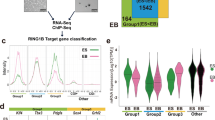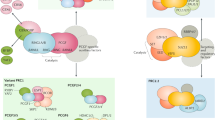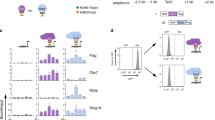Abstract
The Polycomb group (PcG) proteins have an important role in controlling the expression of genes essential for development, differentiation and maintenance of cell fates1,2. The Polycomb repressive complex 2 (PRC2) is believed to regulate transcriptional repression by catalysing the di- and tri-methylation of lysine 27 on histone H3 (H3K27me2/3)2. At present, it is unknown how the PcG proteins are recruited to their target promoters in mammalian cells3. Here we show that PRC2 forms a stable complex with the Jumonji- and ARID-domain-containing protein, JARID2 (ref. 4). Using genome-wide location analysis, we show that JARID2 binds to more than 90% of previously mapped PcG target genes. Notably, we show that JARID2 is sufficient to recruit PcG proteins to a heterologous promoter, and that inhibition of JARID2 expression leads to a major loss of PcG binding and to a reduction of H3K27me3 levels on target genes. Consistent with an essential role for PcG proteins in early development5,6,7,8, we demonstrate that JARID2 is required for the differentiation of mouse embryonic stem cells. Thus, these results demonstrate that JARID2 is essential for the binding of PcG proteins to target genes and, consistent with this, for the proper differentiation of embryonic stem cells and normal development.
This is a preview of subscription content, access via your institution
Access options
Subscribe to this journal
Receive 51 print issues and online access
$199.00 per year
only $3.90 per issue
Buy this article
- Purchase on Springer Link
- Instant access to full article PDF
Prices may be subject to local taxes which are calculated during checkout




Similar content being viewed by others
References
Schuettengruber, B., Chourrout, D., Vervoort, M., Leblanc, B. & Cavalli, G. Genome regulation by polycomb and trithorax proteins. Cell 128, 735–745 (2007)
Schwartz, Y. B. & Pirrotta, V. Polycomb silencing mechanisms and the management of genomic programmes. Nature Rev. Genet. 8, 9–22 (2007)
Bracken, A. P. & Helin, K. Polycomb group proteins: navigators of lineage pathways led astray in cancer. Nature Rev. Cancer 9, 773–784 (2009)
Takeuchi, T., Kojima, M., Nakajima, K. & Kondo, S. jumonji gene is essential for the neurulation and cardiac development of mouse embryos with a C3H/He background. Mech. Dev. 86, 29–38 (1999)
Faust, C., Lawson, K. A., Schork, N. J., Thiel, B. & Magnuson, T. The Polycomb-group gene eed is required for normal morphogenetic movements during gastrulation in the mouse embryo. Development 125, 4495–4506 (1998)
O’Carroll, D. et al. The Polycomb-group gene Ezh2 is required for early mouse development. Mol. Cell. Biol. 21, 4330–4336 (2001)
Pasini, D., Bracken, A. P., Jensen, M. R., Lazzerini Denchi, E. & Helin, K. Suz12 is essential for mouse development and for EZH2 histone methyltransferase activity. EMBO J. 23, 4061–4071 (2004)
Voncken, J. W. et al. Rnf2 (Ring1b) deficiency causes gastrulation arrest and cell cycle inhibition. Proc. Natl Acad. Sci. USA 100, 2468–2473 (2003)
Boyer, L. A. et al. Polycomb complexes repress developmental regulators in murine embryonic stem cells. Nature 441, 349–353 (2006)
Bracken, A. P., Dietrich, N., Pasini, D., Hansen, K. H. & Helin, K. Genome-wide mapping of Polycomb target genes unravels their roles in cell fate transitions. Genes Dev. 20, 1123–1136 (2006)
Lee, T. I. et al. Control of developmental regulators by Polycomb in human embryonic stem cells. Cell 125, 301–313 (2006)
Cao, R. et al. Role of histone H3 lysine 27 methylation in Polycomb-group silencing. Science 298, 1039–1043 (2002)
Cao, R., Tsukada, Y. & Zhang, Y. Role of Bmi-1 and Ring1A in H2A ubiquitylation and Hox gene silencing. Mol. Cell 20, 845–854 (2005)
Kuzmichev, A., Nishioka, K., Erdjument-Bromage, H., Tempst, P. & Reinberg, D. Histone methyltransferase activity associated with a human multiprotein complex containing the Enhancer of Zeste protein. Genes Dev. 16, 2893–2905 (2002)
Czermin, B. et al. Drosophila enhancer of Zeste/ESC complexes have a histone H3 methyltransferase activity that marks chromosomal Polycomb sites. Cell 111, 185–196 (2002)
Müller, J. et al. Histone methyltransferase activity of a Drosophila Polycomb group repressor complex. Cell 111, 197–208 (2002)
Kim, T. G., Kraus, J. C., Chen, J. & Lee, Y. JUMONJI, a critical factor for cardiac development, functions as a transcriptional repressor. J. Biol. Chem. 278, 42247–42255 (2003)
Cloos, P. A., Christensen, J., Agger, K. & Helin, K. Erasing the methyl mark: histone demethylases at the center of cellular differentiation and disease. Genes Dev. 22, 1115–1140 (2008)
Takeuchi, T. et al. Gene trap capture of a novel mouse gene, jumonji, required for neural tube formation. Genes Dev. 9, 1211–1222 (1995)
Kim, T. G., Chen, J., Sadoshima, J. & Lee, Y. Jumonji represses atrial natriuretic factor gene expression by inhibiting transcriptional activities of cardiac transcription factors. Mol. Cell. Biol. 24, 10151–10160 (2004)
Ku, M. et al. Genomewide analysis of PRC1 and PRC2 occupancy identifies two classes of bivalent domains. PLoS Genet. 4, e1000242 (2008)
Pasini, D., Bracken, A. P., Hansen, J. B., Capillo, M. & Helin, K. The Polycomb group protein Suz12 is required for embryonic stem cell differentiation. Mol. Cell. Biol. 27, 3769–3779 (2007)
Chamberlain, S. J., Yee, D. & Magnuson, T. Polycomb repressive complex 2 is dispensable for maintenance of embryonic stem cell pluripotency. Stem Cells 26, 1496–1505 (2008)
Shen, X. et al. EZH1 mediates methylation on histone H3 lysine 27 and complements EZH2 in maintaining stem cell identity and executing pluripotency. Mol. Cell 32, 491–502 (2008)
Pasini, D. et al. Regulation of stem cell differentiation by histone methyltransferases and demethylases. Cold Spring Harb. Symp. Quant. Biol. 73, 253–263 (2008)
Hansen, K. H. et al. A model for transmission of the H3K27me3 epigenetic mark. Nature Cell Biol. 10, 1291–1300 (2008)
Margueron, R. et al. Role of the polycomb protein EED in the propagation of repressive histone marks. Nature 461, 762–767 (2009)
Pasini, D. et al. Coordinated regulation of transcriptional repression by the RBP2 H3K4 demethylase and Polycomb-Repressive Complex 2. Genes Dev. 22, 1345–1355 (2008)
Mikkelsen, T. S. et al. Genome-wide maps of chromatin state in pluripotent and lineage-committed cells. Nature 448, 553–560 (2007)
Villa, R. et al. Role of the polycomb repressive complex 2 in acute promyelocytic leukemia. Cancer Cell 11, 513–525 (2007)
Christensen, J. et al. RBP2 belongs to a family of demethylases, specific for tri-and dimethylated lysine 4 on histone 3. Cell 128, 1063–1076 (2007)
Wilm, M. et al. Femtomole sequencing of proteins from polyacrylamide gels by nano-electrospray mass spectrometry. Nature 379, 466–469 (1996)
Ji, H. et al. An integrated software system for analyzing ChIP-chip and ChIP-seq data. Nature Biotechnol. 26, 1293–1300 (2008)
Acknowledgements
We thank K. Hansen for the RING1B antibody, J. Vikesaa for bioinformatics support, and F. de Lima Alves for assistance during mass spectrometry analyses. We thank L. Morey for critical reading of the manuscript, and members of the Helin laboratory for discussions, technical advice and support. D.P. was supported by a post-doctoral fellowship from the Danish Medical Research Council, P.A.C.C. by a grant from the Benzon Foundation and J.W. by a post-doctoral fellowship from NordForsk (Nordic Union). J.R. is a Senior Research Fellow of the Wellcome Trust. The Wilhelm Johannsen Center is supported by the Danish National Research Foundation and the Lundbeck Foundation. The work in the Helin laboratory was supported by grants from the Danish National Research Foundation, the Danish Cancer Society, the Novo Nordisk Foundation, the Danish Medical Research Council, and the Danish Natural Science Research Council.
Author Contributions D.P. and K.H. conceived and designed the project. D.P. performed experiments in Figs 1a, c, d, 2a, 3 and 4 and Supplementary Figs 1a, c–f, 2a, b, 3b and 4–9. P.A.C.C. designed and performed the experiments in Fig. 1b and Supplementary Figs 1b and 3a. J.W. performed experiments in Fig. 2b–d, Supplementary Figs 2c and 3a. J.-P.B. cloned JARID2. L.O. provided technical support. M.B. and N.T. performed the Solexa sequencing. J.R. performed mass spectrometry analyses. J.V.J. provided bioinformatics support. D.P. and K.H. wrote the manuscript.
Author information
Authors and Affiliations
Corresponding author
Ethics declarations
Competing interests
K.H. and P.A.C.C. are cofounders of EpiTherapeutics and have shares and warrants in the company. All other authors declare that they have no competing financial interests.
Supplementary information
Supplementary Figures
This file contains Supplementary Figures S1-S11 with Legends. (PDF 2348 kb)
Supplementary Table 1
This table contains the chromosomal coordinates of the peaks and the target genes lists of the ChIP-seq experiments. (XLS 2162 kb)
Supplementary Table 2
This table contains the results of the expression arrays of the ES cells differentiation experiment. (XLS 8272 kb)
Supplementary Table 3
This table contains the primer sequences for real-time quantitative PCR and the list of the used antibodies. (XLS 28 kb)
Rights and permissions
About this article
Cite this article
Pasini, D., Cloos, P., Walfridsson, J. et al. JARID2 regulates binding of the Polycomb repressive complex 2 to target genes in ES cells. Nature 464, 306–310 (2010). https://doi.org/10.1038/nature08788
Received:
Accepted:
Published:
Issue Date:
DOI: https://doi.org/10.1038/nature08788
This article is cited by
-
Emerging roles of mitochondrial functions and epigenetic changes in the modulation of stem cell fate
Cellular and Molecular Life Sciences (2024)
-
Unique microRNA expression profiles in plasmic exosomes from intrahepatic cholestasis of pregnancy
BMC Pregnancy and Childbirth (2023)
-
SAMD13 serves as a useful prognostic biomarker for hepatocellular carcinoma
European Journal of Medical Research (2023)
-
Evolutionary adaptation of the Polycomb repressive complex 2
Epigenetics & Chromatin (2022)
-
Dynamic transcriptional activity and chromatin remodeling of regulatory T cells after varied duration of interleukin-2 receptor signaling
Nature Immunology (2022)
Comments
By submitting a comment you agree to abide by our Terms and Community Guidelines. If you find something abusive or that does not comply with our terms or guidelines please flag it as inappropriate.



